Fast Degradation of Tetracycline and Ciprofloxacin in Municipal Water under Hydrodynamic Cavitation/Plasma with CeO2 Nanocatalyst
Abstract
:1. Introduction
2. Materials and Methods
2.1. Reagents
2.2. CeO2 Preparation
2.3. Methods of Analysis
2.4. Sonoplasma Experimental Setup
2.5. Sonoplasma Treatment Procedure
3. Results
3.1. Degradation of Tetracycline and Ciprofloxacin in a Sonoplasma Reactor
3.2. Mechanism of Action
3.3. Effect of Co-Existing Admixtures in the Municipal Water Matrix
3.4. Effect of CeO2 Nanoparticles
3.5. Chemiluminescence Studies
3.6. Possible Modifications to Technological Setup
- high water quality with low energy consumption,
- unlimited productivity at a comparatively small size,
- low OPEX.
4. Conclusions
Supplementary Materials
Author Contributions
Funding
Data Availability Statement
Acknowledgments
Conflicts of Interest
References
- Huang, A.; Yan, M.; Lin, J.; Xu, L.; Gong, H.; Gong, H. A Review of Processes for Removing Antibiotics from Breeding Wastewater. Int. J. Environ. Res. Public Health 2021, 18, 4909. [Google Scholar] [CrossRef]
- Al-Khazrajy, O.S.A.; Bergström, E.; Boxall, A.B.A. Factors Affecting the Dissipation of Pharmaceuticals in Freshwater Sediments. Environ. Toxicol. Chem. 2018, 37, 829–838. [Google Scholar] [CrossRef] [Green Version]
- Rana, M.S.; Lee, S.Y.; Kang, H.J.; Hur, S.J. Reducing Veterinary Drug Residues in Animal Products: A Review. Food Sci. Anim. Resour. 2019, 39, 687–703. [Google Scholar] [CrossRef] [Green Version]
- Mund, M.D.; Khan, U.H.; Tahir, U.; Mustafa, B.-E.; Fayyaz, A. Antimicrobial Drug Residues in Poultry Products and Implications on Public Health: A Review. Int. J. Food Prop. 2017, 20, 1433–1446. [Google Scholar] [CrossRef] [Green Version]
- Boxall, A.B.A.; Sinclair, C.J.; Fenner, K.; Kolpin, D.; Maund, S.J. Peer Reviewed: When Synthetic Chemicals Degrade in the Environment. Environ. Sci. Technol. 2004, 38, 368A–375A. [Google Scholar] [CrossRef] [Green Version]
- Dewil, R.; Mantzavinos, D.; Poulios, I.; Rodrigo, M.A. New Perspectives for Advanced Oxidation Processes. J. Environ. Manag. 2017, 195, 93–99. [Google Scholar] [CrossRef] [Green Version]
- Bowen, W.R. Water Engineering for the Promotion of Peace. Desalin. Water Treat. 2009, 1, 1–6. [Google Scholar] [CrossRef] [Green Version]
- Bartl, A. Moving from Recycling to Waste Prevention: A Review of Barriers and Enables. Waste Manag. Res. J. Int. Solid Wastes Public Clean. Assoc. ISWA 2014, 32, 3–18. [Google Scholar] [CrossRef] [Green Version]
- Ahmad, F.; Zhu, D.; Sun, J. Environmental Fate of Tetracycline Antibiotics: Degradation Pathway Mechanisms, Challenges, and Perspectives. Environ. Sci. Eur. 2021, 33, 64. [Google Scholar] [CrossRef]
- Glaze, W.H.; Kang, J.-W.; Chapin, D.H. The Chemistry of Water Treatment Processes Involving Ozone, Hydrogen Peroxide and Ultraviolet Radiation. Ozone Sci. Eng. 1987, 9, 335–352. [Google Scholar] [CrossRef]
- Lim, S.; Shi, J.L.; von Gunten, U.; McCurry, D.L. Ozonation of Organic Compounds in Water and Wastewater: A Critical Review. Water Res. 2022, 213, 118053. [Google Scholar] [CrossRef]
- Suárez, S.; Carballa, M.; Omil, F.; Lema, J.M. How Are Pharmaceutical and Personal Care Products (PPCPs) Removed from Urban Wastewaters? Rev. Environ. Sci. Bio. Technol. 2008, 7, 125–138. [Google Scholar] [CrossRef]
- Fent, K.; Weston, A.A.; Caminada, D. Ecotoxicology of Human Pharmaceuticals. Aquat. Toxicol. 2006, 76, 122–159. [Google Scholar] [CrossRef]
- Manasfi, T. Chapter Four—Ozonation in Drinking Water Treatment: An Overview of General and Practical Aspects, Mechanisms, Kinetics, and Byproduct Formation. In Analysis and Formation of Disinfection Byproducts in Drinking Water; Manasfi, T., Boudenne, J.-L., Eds.; Elsevier: Amsterdam, The Netherlands, 2021; Volume 92, pp. 85–116. ISBN 0166-526X. [Google Scholar]
- Carey, J.H. An Introduction to Advanced Oxidation Processes (AOP) for Destruction of Organics in Wastewater. Water Qual. Res. J. 1992, 27, 1–22. [Google Scholar] [CrossRef]
- Mahamuni, N.N.; Adewuyi, Y.G. Advanced Oxidation Processes (AOPs) Involving Ultrasound for Waste Water Treatment: A Review with Emphasis on Cost Estimation. Ultrason. Sonochem. 2010, 17, 990–1003. [Google Scholar] [CrossRef]
- Hart, E.J.; Henglein, A. Sonolysis of Ozone in Aqueous Solution. J. Phys. Chem. 1986, 90, 3061–3062. [Google Scholar] [CrossRef]
- Kidak, R.; Ince, N.H. Catalysis of Advanced Oxidation Reactions by Ultrasound: A Case Study with Phenol. J. Hazard. Mater. 2007, 146, 630–635. [Google Scholar] [CrossRef]
- Yang, L.P.; Hu, W.Y.; Huang, H.M.; Yan, B. Degradation of High Concentration Phenol by Ozonation in Combination with Ultrasonic Irradiation. Desalin. Water Treat. 2010, 21, 87–95. [Google Scholar] [CrossRef]
- Tezcanli-Güyer, G.; Ince, N.H. Individual and Combined Effects of Ultrasound, Ozone and UV Irradiation: A Case Study with Textile Dyes. Ultrasonics 2004, 42, 603–609. [Google Scholar] [CrossRef]
- Wu, Z.; Abramova, A.; Nikonov, R.; Cravotto, G. Sonozonation (Sonication/Ozonation) for the Degradation of Organic Contaminants—A Review. Ultrason. Sonochem. 2020, 68, 105195. [Google Scholar] [CrossRef]
- Werner, J.J.; Arnold, W.A.; McNeill, K. Water Hardness as a Photochemical Parameter: Tetracycline Photolysis as a Function of Calcium Concentration, Magnesium Concentration, and PH. Environ. Sci. Technol. 2006, 40, 7236–7241. [Google Scholar] [CrossRef]
- Wei, X.; Chen, J.; Xie, Q.; Zhang, S.; Ge, L.; Qiao, X. Distinct Photolytic Mechanisms and Products for Different Dissociation Species of Ciprofloxacin. Environ. Sci. Technol. 2013, 47, 4284–4290. [Google Scholar] [CrossRef]
- Nguyen, L.T.; Nguyen, H.T.; Pham, T.-D.; Tran, T.D.; Chu, H.T.; Dang, H.T.; Nguyen, V.-H.; Nguyen, K.M.; Pham, T.T.; Van der Bruggen, B. UV–Visible Light Driven Photocatalytic Degradation of Ciprofloxacin by N,S Co-Doped TiO2: The Effect of Operational Parameters. Top. Catal. 2020, 63, 985–995. [Google Scholar] [CrossRef]
- Foster, J.E. Plasma-Based Water Purification: Challenges and Prospects for the Future. Phys. Plasmas 2017, 24, 55501. [Google Scholar] [CrossRef]
- Šunka, P. Pulse Electrical Discharges in Water and Their Applications. Phys. Plasmas 2001, 8, 2587–2594. [Google Scholar] [CrossRef]
- Yang, Y.; Fridman, A.; Cho, Y.I. Plasma Discharge in Water. In Advances in Heat Transfer; Cho, Y.I., Greene, G.A., Eds.; Elsevier: Amsterdam, The Netherlands, 2010; Volume 42, pp. 179–292. ISBN 0065-2717. [Google Scholar]
- Malik, M.A.; Ghaffar, A.; Malik, S.A. Water Purification by Electrical Discharges. Plasma Sources Sci. Technol. 2001, 10, 82–91. [Google Scholar] [CrossRef]
- Malik, M.A. Water Purification by Plasmas: Which Reactors Are Most Energy Efficient? Plasma Chem. Plasma Process. 2010, 30, 21–31. [Google Scholar] [CrossRef]
- Abramov, V.O.; Abramova, A.V.; Cravotto, G.; Nikonov, R.V.; Fedulov, I.S.; Ivanov, V.K. Flow-Mode Water Treatment under Simultaneous Hydrodynamic Cavitation and Plasma. Ultrason. Sonochem. 2021, 70, 105323. [Google Scholar] [CrossRef]
- Nawrocki, J.; Kasprzyk-Hordern, B. The Efficiency and Mechanisms of Catalytic Ozonation. Appl. Catal. B Environ. 2010, 99, 27–42. [Google Scholar] [CrossRef]
- Fu, J.; Liu, N.; Mei, L.; Liao, L.; Deyneko, D.; Wang, J.; Bai, Y.; Lv, G. Synthesis of Ce-Doped Mn3Gd7−xCex(SiO4)6O1.5 for the Enhanced Catalytic Ozonation of Tetracycline. Sci. Rep. 2019, 9, 18734. [Google Scholar] [CrossRef]
- Soltani, R.D.C.; Mashayekhi, M.; Naderi, M.; Boczkaj, G.; Jorfi, S.; Safari, M. Sonocatalytic Degradation of Tetracycline Antibiotic Using Zinc Oxide Nanostructures Loaded on Nano-Cellulose from Waste Straw as Nanosonocatalyst. Ultrason. Sonochem. 2019, 55, 117–124. [Google Scholar] [CrossRef] [PubMed]
- Hassani, A.; Khataee, A.; Karaca, S.; Karaca, C.; Gholami, P. Sonocatalytic Degradation of Ciprofloxacin Using Synthesized TiO2 Nanoparticles on Montmorillonite. Ultrason. Sonochem. 2017, 35, 251–262. [Google Scholar] [CrossRef] [PubMed]
- Semeraro, P.; Bettini, S.; Sawalha, S.; Pal, S.; Licciulli, A.; Marzo, F.; Lovergine, N.; Valli, L.; Giancane, G. Photocatalytic Degradation of Tetracycline by ZnO/γ-Fe2O3 Paramagnetic Nanocomposite Material. Nanomaterials 2020, 10, 1458. [Google Scholar] [CrossRef] [PubMed]
- Kümmerer, K. Antibiotics in the Aquatic Environment—A Review—Part II. Chemosphere 2009, 75, 435–441. [Google Scholar] [CrossRef]
- Shcherbakov, A.B.; Teplonogova, M.A.; Ivanova, O.S.; Shekunova, T.O.; Ivonin, I.V.; Baranchikov, A.Y.; Ivanov, V.K. Facile Method for Fabrication of Surfactant-Free Concentrated CeO2 Sols. Mater. Res. Express 2017, 4, 55008. [Google Scholar] [CrossRef]
- DeWitte, B.; Dewulf, J.; Demeestere, K.; Van De Vyvere, V.; De Wispelaere, P.; Van Langenhove, H. Ozonation of Ciprofloxacin in Water: HRMS Identification of Reaction Products and Pathways. Environ. Sci. Technol. 2008, 42, 4889–4895. [Google Scholar] [CrossRef]
- Daiber, A.; Oelze, M.; August, M.; Wendt, M.; Sydow, K.; Wieboldt, H.; Kleschyov, A.L.; Munzel, T. Detection of Superoxide and Peroxynitrite in Model Systems and Mitochondria by the Luminol Analogue L-012. Free Radic. Res. 2004, 38, 259–269. [Google Scholar] [CrossRef]
- Zielonka, J.; Lambeth, J.D.; Kalyanaraman, B. On the Use of L-012, a Luminol-Based Chemiluminescent Probe, for Detecting Superoxide and Identifying Inhibitors of NADPH Oxidase: A Reevaluation. Free Radic. Biol. Med. 2013, 65, 1310–1314. [Google Scholar] [CrossRef] [Green Version]
- Smith, M.J.; Fowler, M.; Naftalin, R.J.; Siow, R.C.M. UVA Irradiation Increases Ferrous Iron Release from Human Skin Fibroblast and Endothelial Cell Ferritin: Consequences for Cell Senescence and Aging. Free Radic. Biol. Med. 2020, 155, 49–57. [Google Scholar] [CrossRef]
- Snehalatha, M.; Ravikumar, C.; Hubert Joe, I.; Sekar, N.; Jayakumar, V.S. Spectroscopic Analysis and DFT Calculations of a Food Additive Carmoisine. Spectrochim. Acta Part A Mol. Biomol. Spectrosc. 2009, 72, 654–662. [Google Scholar] [CrossRef]
- Leulescu, M.; Rotaru, A.; Moanţă, A.; Iacobescu, G.; Pălărie, I.; Cioateră, N.; Popescu, M.; Criveanu, M.C.; Morîntale, E.; Bojan, M.; et al. Azorubine: Physical, Thermal and Bioactive Properties of the Widely Employed Food, Pharmaceutical and Cosmetic Red Azo Dye Material. J. Therm. Anal. Calorim. 2021, 143, 3945–3967. [Google Scholar] [CrossRef]
- Didenko, Y.T.; Pugach, S.P. Spectra of Water Sonoluminescence. J. Phys. Chem. 1994, 98, 9742–9749. [Google Scholar] [CrossRef]
- Yasui, K. Multibubble Sonoluminescence from a Theoretical Perspective. Molecules 2021, 26, 4624. [Google Scholar] [CrossRef]
- Baranchikov, A.Y.; Ivanov, V.K.; Tretyakov, Y.D. Sonochemical Synthesis of Inorganic Materials. Russ. Chem. Rev. 2007, 76, 133–151. [Google Scholar] [CrossRef]
- Serna-Galvis, E.A.; Botero-Coy, A.M.; Martínez-Pachón, D.; Moncayo-Lasso, A.; Ibáñez, M.; Hernández, F.; Torres-Palma, R.A. Degradation of Seventeen Contaminants of Emerging Concern in Municipal Wastewater Effluents by Sonochemical Advanced Oxidation Processes. Water Res. 2019, 154, 349–360. [Google Scholar] [CrossRef] [PubMed]
- Shurbaji, S.; Huong, P.T.; Altahtamouni, T.M. Review on the Visible Light Photocatalysis for the Decomposition of Ciprofloxacin, Norfloxacin, Tetracyclines, and Sulfonamides Antibiotics in Wastewater. Catalysts 2021, 11, 437. [Google Scholar] [CrossRef]
- Karim, A.V.; Shriwastav, A. Degradation of Ciprofloxacin Using Photo, Sono, and Sonophotocatalytic Oxidation with Visible Light and Low-Frequency Ultrasound: Degradation Kinetics and Pathways. Chem. Eng. J. 2020, 392, 124853. [Google Scholar] [CrossRef]
- Swamy, N.K.; Mohana, K.N.S.; Yashas, S.R. GNR@CeO2 Heterojunction as a Novel Sonophotocatalyst: Degradation of Tetracycline Hydrochloride, Kinetic Modeling and Synergistic Effects. Colloids Surf. A Physicochem. Eng. Asp. 2022, 639, 128324. [Google Scholar] [CrossRef]
- Xu, L.; Wu, X.-Q.; Wang, F.-J.; Liu, N.-P.; Wang, S.-H.; An, H.-L.; Ju, W.-T.; Lu, W.; Liu, B.; Wang, X.-F.; et al. Sonocatalytic Degradation of Tetracycline by Biobr/Fewo4 Nanomaterials in Collaboration with Potassium Persulfate. SSRN Electron. J. 2022. [Google Scholar] [CrossRef]
- Soori, M.M.; Ghahramani, E.; Kazemian, H.; Al-Musawi, T.J.; Zarrabi, M. Intercalation of Tetracycline in Nano Sheet Layered Double Hydroxide: An Insight into UV/VIS Spectra Analysis. J. Taiwan Inst. Chem. Eng. 2016, 63, 271–285. [Google Scholar] [CrossRef]
- Matavos-Aramyan, S.; Moussavi, M. Advances in Fenton and Fenton Based Oxidation Processes for Industrial Effluent Contaminants Control-A Review. Int. J. Environ. Sci. Nat. Resour. 2017, 2, 555594. [Google Scholar] [CrossRef] [Green Version]
- Saleh, R.; Taufik, A. Degradation of Methylene Blue and Congo-Red Dyes Using Fenton, Photo-Fenton, Sono-Fenton, and Sonophoto-Fenton Methods in the Presence of Iron(II, III) Oxide/Zinc Oxide/Graphene (Fe3O4/ZnO/Graphene) Composites. Sep. Purif. Technol. 2019, 210, 563–573. [Google Scholar] [CrossRef]
- Dükkancı, M. Sono-Photo-Fenton Oxidation of Bisphenol-A over a LaFeO3 Perovskite Catalyst. Ultrason. Sonochem. 2018, 40, 110–116. [Google Scholar] [CrossRef] [PubMed]
- Andreozzi, R.; Caprio, V.; Insola, A.; Marotta, R. Advanced Oxidation Processes (AOP) for Water Purification and Recovery. Catal. Today 1999, 53, 51–59. [Google Scholar] [CrossRef]
- Bhattacharjee, S.; Shah, Y.T. Mechanisms for advanced photooxidation of aqueous organic waste compounds. Rev. Chem. Eng. 1998, 14, 1–46. [Google Scholar] [CrossRef]
- González Labrada, K.; Alcorta Cuello, D.R.; Saborit Sánchez, I.; García Batle, M.; Manero, M.-H.; Barthe, L.; Jáuregui-Haza, U.J. Optimization of Ciprofloxacin Degradation in Wastewater by Homogeneous Sono-Fenton Process at High Frequency. J. Environ. Sci. Health Part A 2018, 53, 1139–1148. [Google Scholar] [CrossRef] [Green Version]
- Konstantinou, I.K.; Albanis, T.A. TiO2-Assisted Photocatalytic Degradation of Azo Dyes in Aqueous Solution: Kinetic and Mechanistic Investigations: A Review. Appl. Catal. B Environ. 2004, 49, 1–14. [Google Scholar] [CrossRef]
- Sivasankar, T.; Moholkar, V.S. Mechanistic Approach to Intensification of Sonochemical Degradation of Phenol. Chem. Eng. J. 2009, 149, 57–69. [Google Scholar] [CrossRef]
- Shchukin, D.G.; Skorb, E.; Belova, V.; Möhwald, H. Ultrasonic Cavitation at Solid Surfaces. Adv. Mater. 2011, 23, 1922–1934. [Google Scholar] [CrossRef]
- Suslick, K.S.; Didenko, Y.; Fang, M.M.; Hyeon, T.; Kolbeck, K.J.; McNamara, W.B.; Mdleleni, M.M.; Wong, M. Acoustic Cavitation and Its Chemical Consequences. Philos. Trans. R. Soc. London. Ser. A Math. Phys. Eng. Sci. 1999, 357, 335–353. [Google Scholar] [CrossRef]
- Putterman, S.J.; Weninger, K.R. Sonoluminescence: How Bubbles Turn Sound into Light. Annu. Rev. Fluid Mech. 2000, 32, 445–476. [Google Scholar] [CrossRef]
- Geng, N.; Chen, W.; Xu, H.; Ding, M.; Xie, Z.; Wang, A. Removal of Tetracycline Hydrochloride by Z-Scheme Heterojunction Sono-Catalyst Acting on Ultrasound/H2O2 System. Process Saf. Environ. Prot. 2022, 165, 93–101. [Google Scholar] [CrossRef]
- Smijs, T.G.; Pavel, S. Titanium Dioxide and Zinc Oxide Nanoparticles in Sunscreens: Focus on Their Safety and Effectiveness. Nanotechnol. Sci. Appl. 2011, 4, 95–112. [Google Scholar] [CrossRef] [Green Version]
- Ji, P.; Wang, L.; Chen, F.; Zhang, J. Ce3+-Centric Organic Pollutant Elimination by CeO2 in the Presence of H2O2. ChemCatChem 2010, 2, 1552–1554. [Google Scholar] [CrossRef]
- Tizhoosh, N.Y.; Khataee, A.; Hassandoost, R.; Darvishi Cheshmeh Soltani, R.; Doustkhah, E. Ultrasound-Engineered Synthesis of WS2@CeO2 Heterostructure for Sonocatalytic Degradation of Tylosin. Ultrason. Sonochem. 2020, 67, 105114. [Google Scholar] [CrossRef] [PubMed]
- Lu, C.; Song, G.; Lin, J.M. Reactive oxygen species and their chemiluminescence-detection methods. Trends Anal. Chem. 2006, 25, 985–995. [Google Scholar] [CrossRef]
- Yu, W.; Zhao, L. Chemiluminescence detection of reactive oxygen species generation and potential environmental applications. Trends Analyt. Chem. 2021, 136, 116197. [Google Scholar] [CrossRef]
- Agarwal, A.; Allamaneni, S.S.; Said, T.M. Chemiluminescence technique for measuring reactive oxygen species. Reprod. BioMed. Online 2004, 9, 466–468. [Google Scholar] [CrossRef]
- Su, Y.; Song, H.; Lv, Y. Recent advances in chemiluminescence for reactive oxygen species sensing and imaging analysis. Microchem. J. 2019, 146, 83–97. [Google Scholar] [CrossRef]
- Kobayashi, H.; Gil-Guzman, E.; Mahran, A.M.; Sharma, R.K.; Nelson, D.R.; Agarwal, A. Quality control of reactive oxygen species measurement by luminol-dependent chemiluminescence assay. J. Androl. 2001, 22, 568–574. [Google Scholar] [CrossRef]
- Boleda, M.R.; Majamaa, K.; Aerts, P.; Gómez, V.; Galceran, M.T.; Ventura, F. Removal of drugs of abuse from municipal wastewater using reverse osmosis membranes. Desalination Water Treat. 2010, 21, 122–130. [Google Scholar] [CrossRef]
- Dolar, D.; Pelko, S.; Košutić, K.; Horvat, A.J. Removal of anthelmintic drugs and their photodegradation products from water with RO/NF membranes. Process Saf. Environ. Prot. 2012, 90, 147–152. [Google Scholar] [CrossRef]
- Belkacem, M.; Bekhti, S.; Bensadok, K. Groundwater Treatment by Reverse Osmosis. Desalination 2007, 206, 100–106. [Google Scholar] [CrossRef]
- Almansoori, A.; Saif, Y. Structural Optimization of Osmosis Processes for Water and Power Production in Desalination Applications. Desalination 2014, 344, 12–27. [Google Scholar] [CrossRef]
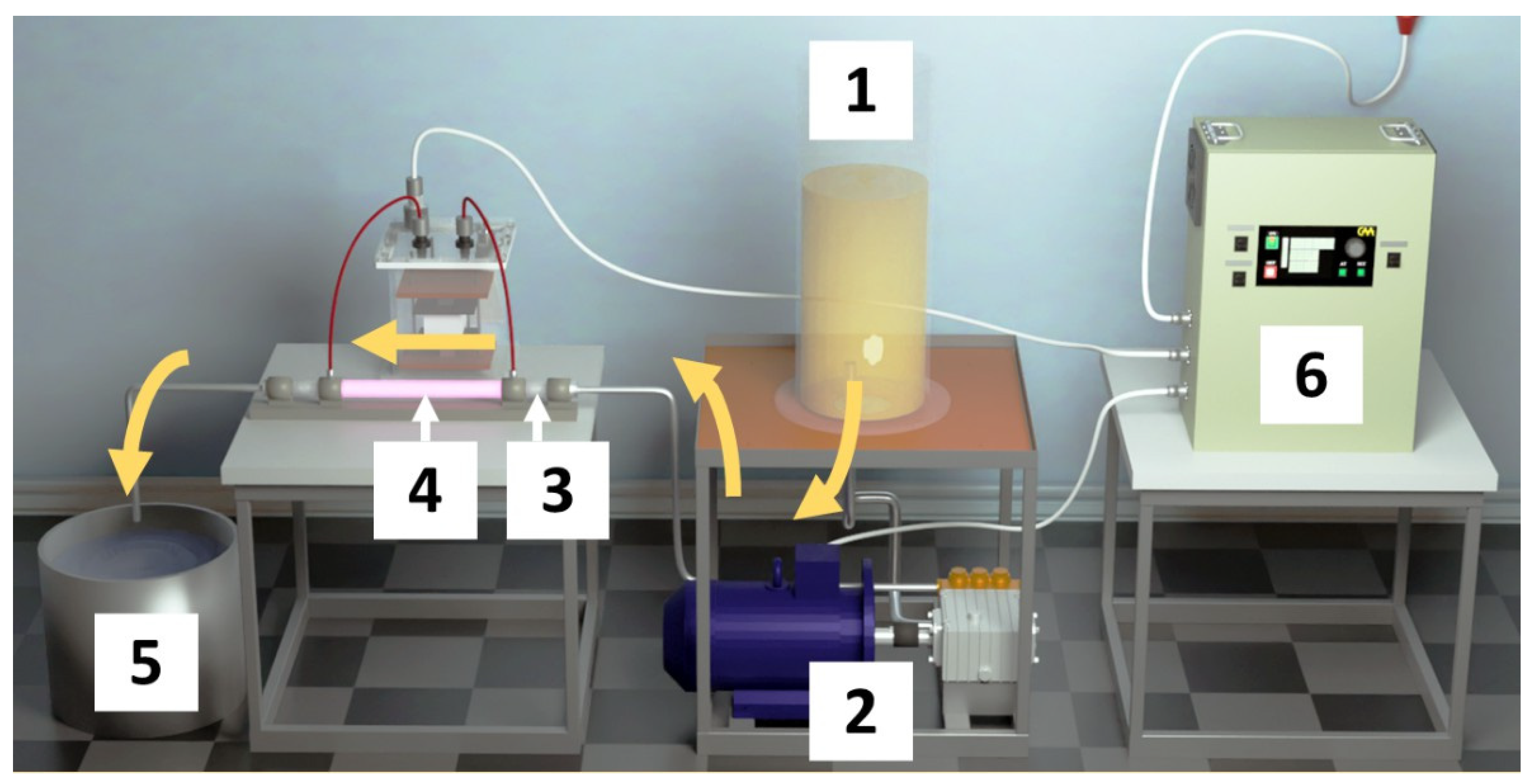
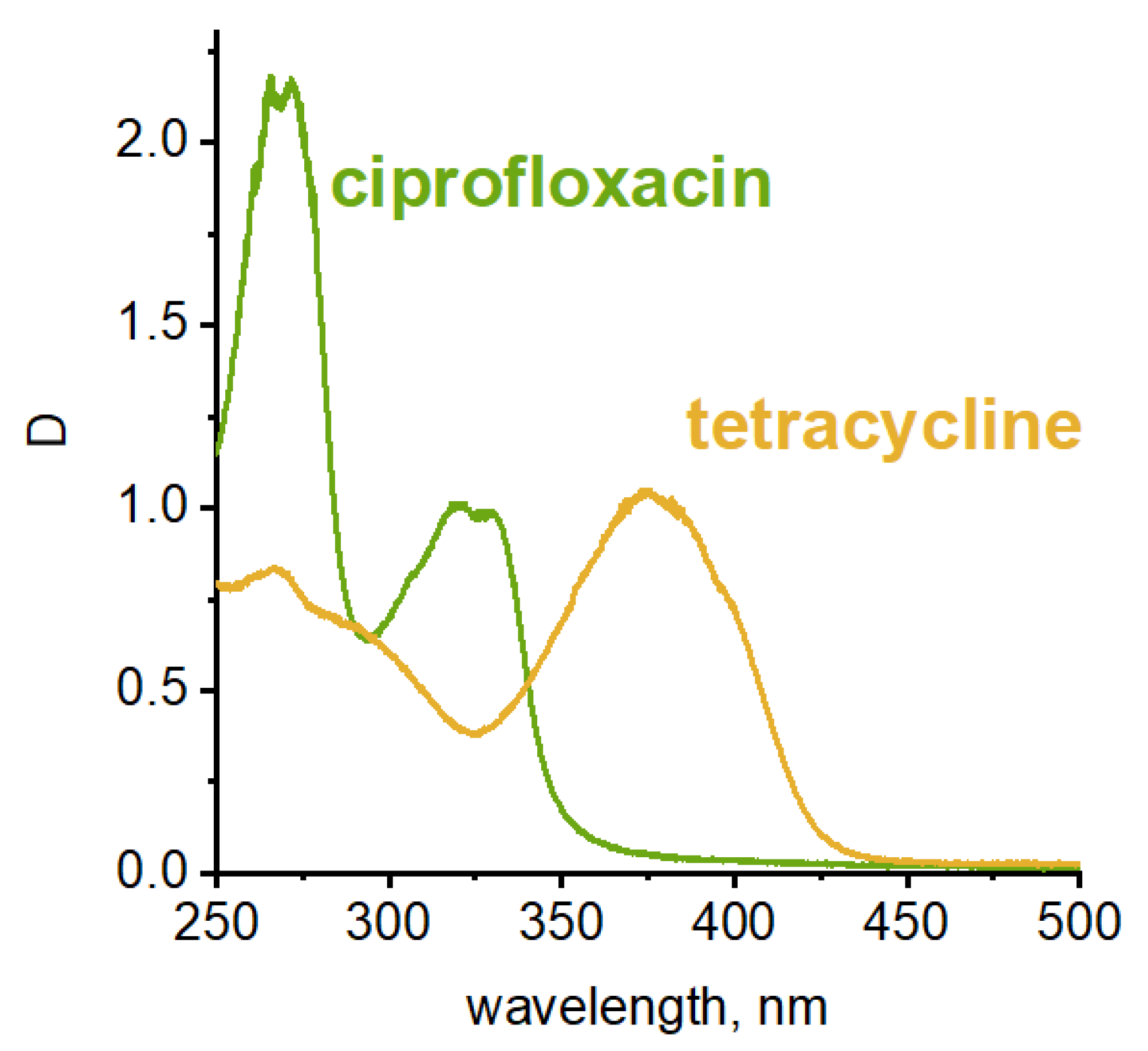

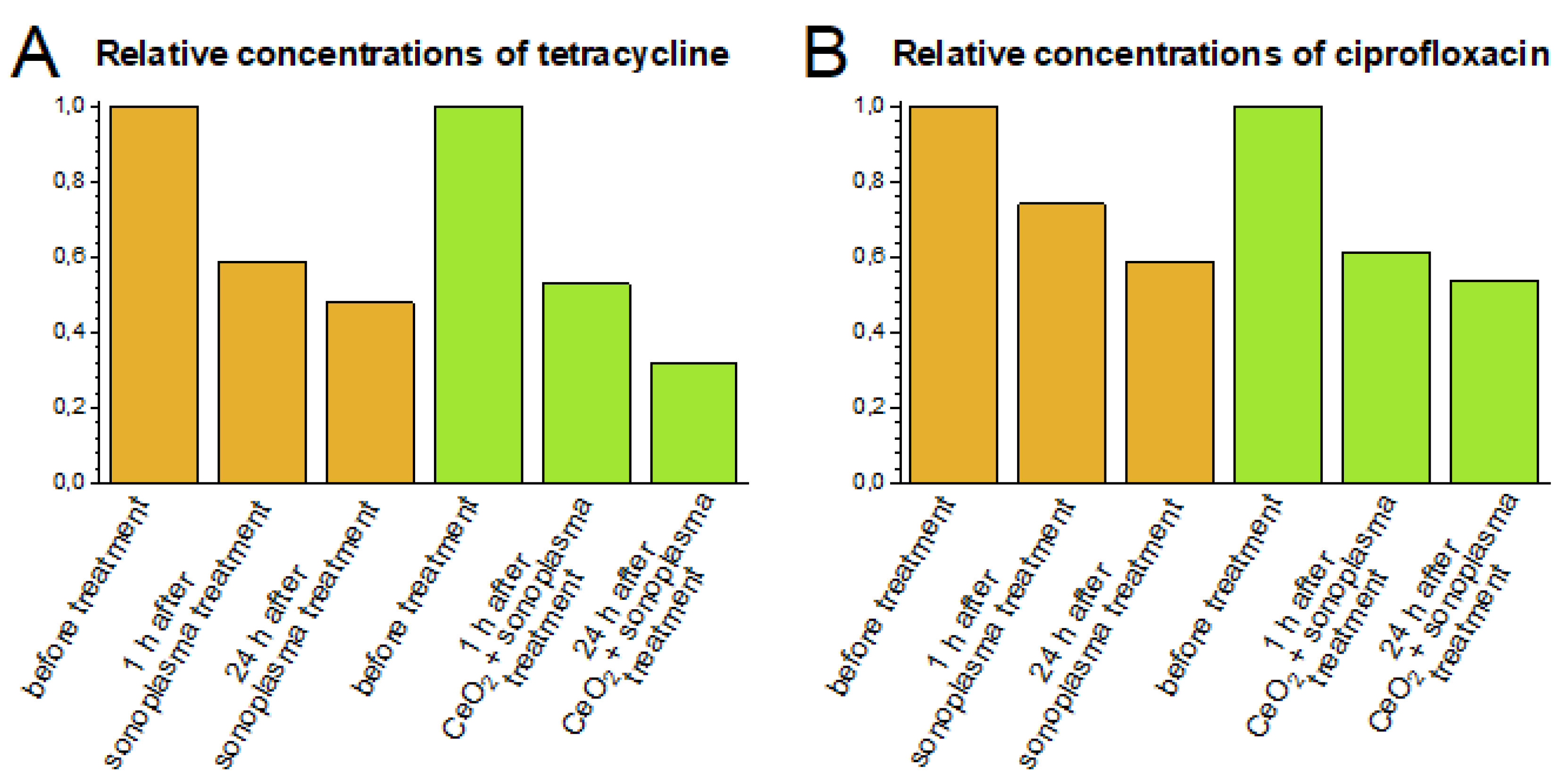
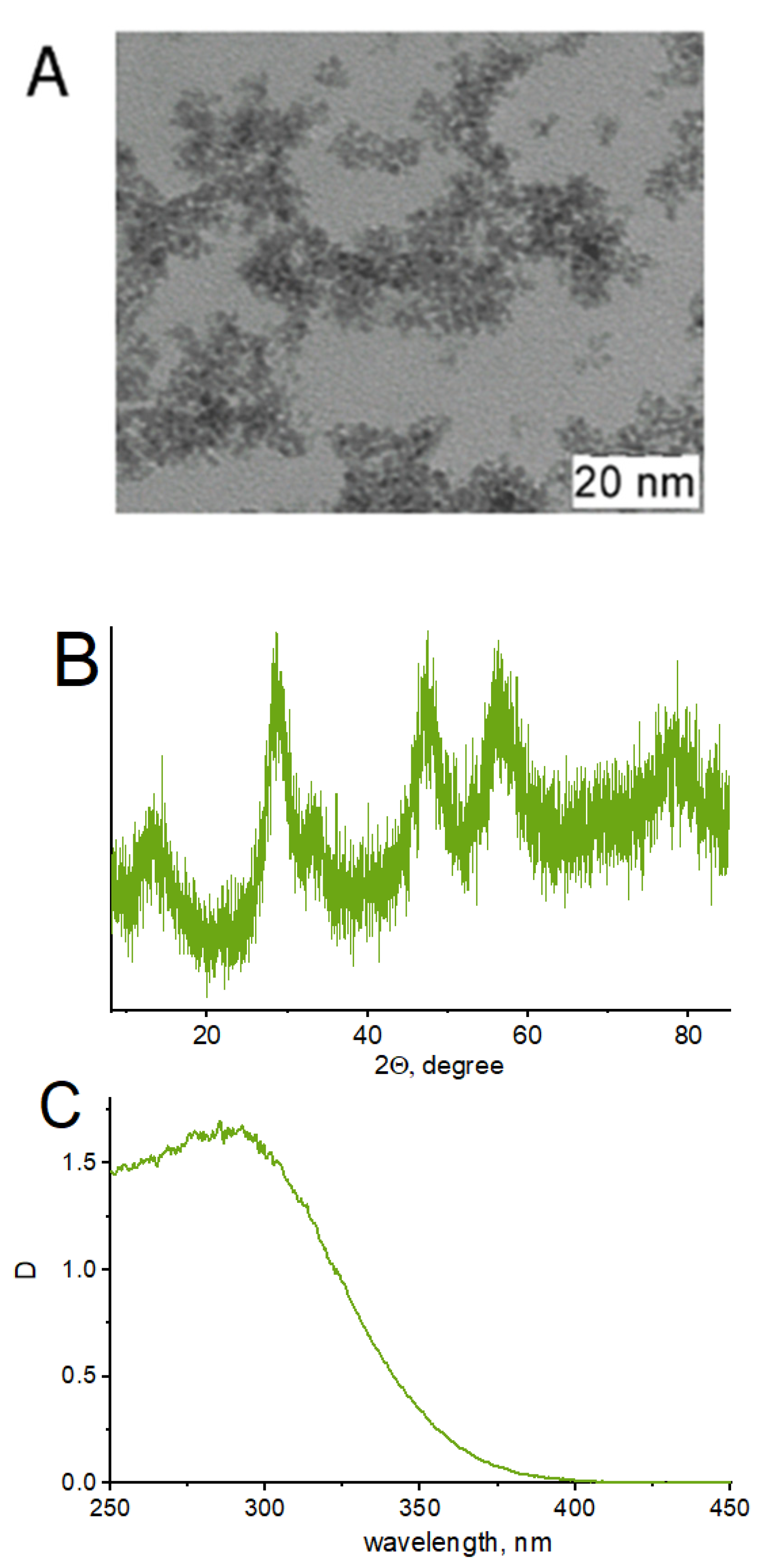
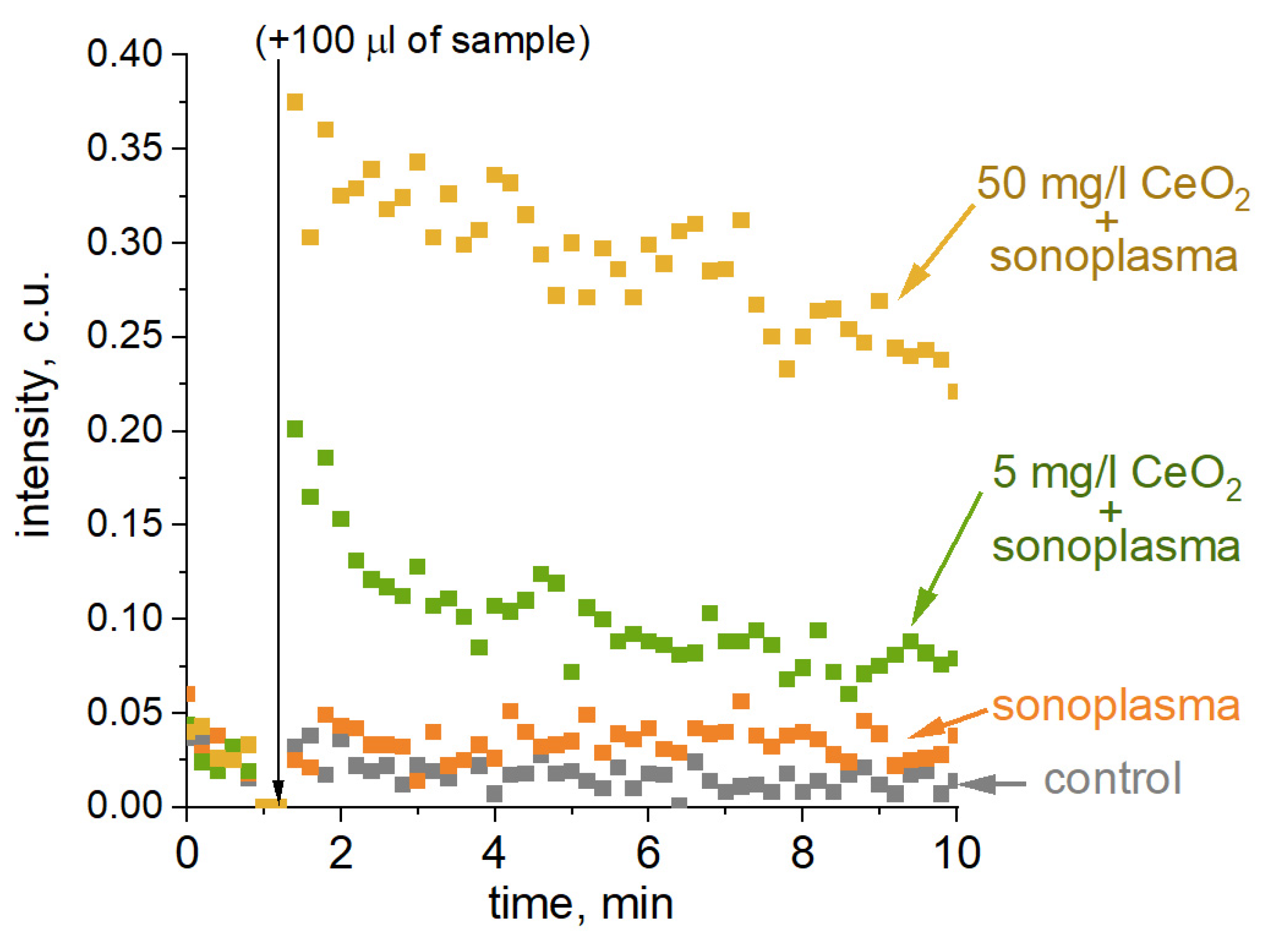

Publisher’s Note: MDPI stays neutral with regard to jurisdictional claims in published maps and institutional affiliations. |
© 2022 by the authors. Licensee MDPI, Basel, Switzerland. This article is an open access article distributed under the terms and conditions of the Creative Commons Attribution (CC BY) license (https://creativecommons.org/licenses/by/4.0/).
Share and Cite
Abramov, V.; Abramova, A.; Bayazitov, V.; Kameneva, S.; Veselova, V.; Kozlov, D.; Sozarukova, M.; Baranchikov, A.; Fedulov, I.; Nikonov, R.; et al. Fast Degradation of Tetracycline and Ciprofloxacin in Municipal Water under Hydrodynamic Cavitation/Plasma with CeO2 Nanocatalyst. Processes 2022, 10, 2063. https://doi.org/10.3390/pr10102063
Abramov V, Abramova A, Bayazitov V, Kameneva S, Veselova V, Kozlov D, Sozarukova M, Baranchikov A, Fedulov I, Nikonov R, et al. Fast Degradation of Tetracycline and Ciprofloxacin in Municipal Water under Hydrodynamic Cavitation/Plasma with CeO2 Nanocatalyst. Processes. 2022; 10(10):2063. https://doi.org/10.3390/pr10102063
Chicago/Turabian StyleAbramov, Vladimir, Anna Abramova, Vadim Bayazitov, Svetlana Kameneva, Varvara Veselova, Daniil Kozlov, Madina Sozarukova, Alexander Baranchikov, Igor Fedulov, Roman Nikonov, and et al. 2022. "Fast Degradation of Tetracycline and Ciprofloxacin in Municipal Water under Hydrodynamic Cavitation/Plasma with CeO2 Nanocatalyst" Processes 10, no. 10: 2063. https://doi.org/10.3390/pr10102063





